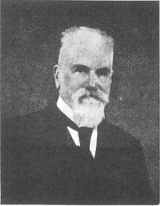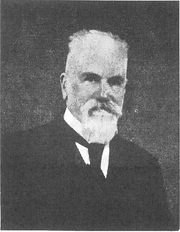
Arie de Jong
Encyclopedia

Putten
Putten is a municipality and a town in Gelderland province in the middle of the Netherlands. In 2007 it had a population of 23,024.Putten is surrounded by a great variety of landscapes. To the east of Putten lies the Veluwe, the biggest national park of the Netherlands...
, Netherlands
Netherlands
The Netherlands is a constituent country of the Kingdom of the Netherlands, located mainly in North-West Europe and with several islands in the Caribbean. Mainland Netherlands borders the North Sea to the north and west, Belgium to the south, and Germany to the east, and shares maritime borders...
) was a Dutch enthusiast and reformer of the constructed language Volapük
Volapük
Volapük is a constructed language, created in 1879–1880 by Johann Martin Schleyer, a Roman Catholic priest in Baden, Germany. Schleyer felt that God had told him in a dream to create an international language. Volapük conventions took place in 1884 , 1887 and 1889 . The first two conventions used...
by Johann Martin Schleyer
Johann Martin Schleyer
Martin Schleyer was a German Catholic priest who invented the constructed language Volapük. His official name was "Martin Schleyer"; he added the name "Johann" unofficially....
, with whose help the Volapük movement gained new strength in the Netherlands. He not only revised Volapük, but also (together with other Volapükist contemporaries) began Volapükaklub Valemik Nedänik (Dutch Universal Volapük Club) and founded Diläd valemik Feda Volapükaklubas. He also founded and edited Volapükagased pro Nedänapükans, an independent newspaper in Volapük, which ran for thirty-one years. (1932-1963.) He wrote Gramat Volapüka, a grammar of the language completely in Volapük, and a German-Volapük dictionary, Wörterbuch der Weltsprache (World Language Dictionary). He translated the New Testament into Volapük from Greek, as well as many other pieces of literature. Arie de Jong is justly considered the most important Volapükist of a new age of Volapük history.
Early life and medical career
Arie de Jong was born on October 18, 1865 to happy parents in Batavia (now JakartaJakarta
Jakarta is the capital and largest city of Indonesia. Officially known as the Special Capital Territory of Jakarta, it is located on the northwest coast of Java, has an area of , and a population of 9,580,000. Jakarta is the country's economic, cultural and political centre...
) in then Dutch East Indies
Dutch East Indies
The Dutch East Indies was a Dutch colony that became modern Indonesia following World War II. It was formed from the nationalised colonies of the Dutch East India Company, which came under the administration of the Netherlands government in 1800....
. In 1873, his family moved to Leiden, Netherlands, where he attended grammar-school (1873-1883) and studied medicine
Medicine
Medicine is the science and art of healing. It encompasses a variety of health care practices evolved to maintain and restore health by the prevention and treatment of illness....
(1883-1891) at Leiden University
Leiden University
Leiden University , located in the city of Leiden, is the oldest university in the Netherlands. The university was founded in 1575 by William, Prince of Orange, leader of the Dutch Revolt in the Eighty Years' War. The royal Dutch House of Orange-Nassau and Leiden University still have a close...
. In February 1891, he received his Doctorate diploma; in March, he became a military medical officer (stationed in East India); briefly afterward, on September 8, he became a university medical doctor in Freiburg
Freiburg
Freiburg im Breisgau is a city in Baden-Württemberg, Germany. In the extreme south-west of the country, it straddles the Dreisam river, at the foot of the Schlossberg. Historically, the city has acted as the hub of the Breisgau region on the western edge of the Black Forest in the Upper Rhine Plain...
by means of his dissertation: "Über Diuretin" (On Diuresis
Diuresis
Diuresis may refer to:* Urine production, as an aspect of fluid balance* Excessive urine production - see polyuria* Immersion diuresis...
).
On February 18, 1892, de Jong married Maria Elisabeth Wilhelmina Clarkson in Ginneken, and the couple left by a ship by the name of Princess Sophie after only one month, on March 22, towards Dutch East Indies. Maria, however, died aboard ship on the Red Sea
Red Sea
The Red Sea is a seawater inlet of the Indian Ocean, lying between Africa and Asia. The connection to the ocean is in the south through the Bab el Mandeb strait and the Gulf of Aden. In the north, there is the Sinai Peninsula, the Gulf of Aqaba, and the Gulf of Suez...
, on the first day of April. Nineteen days later, Arie reached the city of Batavia alone, and on the 25th, he decided to depart to his workshop in Makassar
Makassar
Makassar, is the provincial capital of South Sulawesi, Indonesia, and the largest city on Sulawesi Island. From 1971 to 1999, the city was named Ujung Pandang, after a precolonial fort in the city, and the two names are often used interchangeably...
.
In 1893, he was relocated to Bonthain (now Bantaeng in South Sulawesi
South Sulawesi
South Sulawesi is a province of Indonesia, located on the western southern peninsula of Sulawesi Island. The province is bordered by Central Sulawesi province to the north, South East Sulawesi province to the east and West Sulawesi province to the west...
); in 1896, to Padang
Padang, Indonesia
Padang is the capital and largest city of West Sumatra, Indonesia. It is located on the western coast of Sumatra at . It has an area of and a population of over 833,000 people at the 2010 Census.-History:...
and also to Aceh
Aceh
Aceh is a special region of Indonesia, located on the northern tip of the island of Sumatra. Its full name is Daerah Istimewa Aceh , Nanggroë Aceh Darussalam and Aceh . Past spellings of its name include Acheh, Atjeh and Achin...
; in 1898, to Sintang, where he married for the second time, to Elise Marie Wilhelmine Gerardine Chavannes. In 1900, he became a first-class medical officer; in 1902, below he was relocated, first to Semarang
Semarang
- Economy :The western part of the city is home to many industrial parks and factories. The port of Semarang is located on the north coast and it is the main shipping port for the province of Central Java. Many small manufacturers are located in Semarang, producing goods such as textiles,...
and later to Ungaran
Ungaran
Ungaran is the capital city in the Semarang Regency in the province of Central Java, Indonesia. Ungaran is located at -7.13972 , 110.405 at an elevation/altitude of meters. The average elevation of Ungaran, Indonesia is 319 meters...
; in 1904 he returned to Semarang. By that time he had already lost his two children: Marie Eugène, who was born in 1900 and died the following year, and another child who was stillborn.
In 1904 he enjoyed leisure for a year, during which he spent time in Europe
Europe
Europe is, by convention, one of the world's seven continents. Comprising the westernmost peninsula of Eurasia, Europe is generally 'divided' from Asia to its east by the watershed divides of the Ural and Caucasus Mountains, the Ural River, the Caspian and Black Seas, and the waterways connecting...
. Having returned in 1905 to East Indies, he was sent to Pelantoengan, in 1908 to Yogyakarta
Yogyakarta (city)
Yogyakarta is a city in the Yogyakarta Special Region, Indonesia. It is renowned as a centre of classical Javanese fine art and culture such as batik, ballet, drama, music, poetry, and puppet shows. Yogyakarta was the Indonesian capital during the Indonesian National Revolution from 1945 to...
, and in 1911 to Magelang
Magelang
Magelang is one of the largest cities of the 1,130 km² Magelang Regency, Central Java, Indonesia. It is also the largest town in the Kedu Plain between Mount Merbabu and Mount Sumbing in Central Java, Indonesia...
, where for in eight years he would become a second-class medical officer. In 1912 he was relocated to Banjarmasin
Banjarmasin
Banjarmasin is the capital of South Kalimantan, Indonesia. It is located on a delta island near the junction of the Barito and Martapura rivers. As a result, Banjarmasin is sometimes called the "River City"...
; the following year, he had leisure in Europe for nine months. When he returned to East Indies, he was sent to Surabaya
Surabaya
Surabaya is Indonesia's second-largest city with a population of over 2.7 million , and the capital of the province of East Java...
where, at the end of 1914 he became a higher-ranked first-class medical officer. He was sent in 1915 to Malano, where his second wife, Elise Marie, died.
At that time Dutch East Indies still much needed to be organized and improved. Arie de Jong had an important role for these years in the struggle against many tropical disease
Tropical disease
Tropical diseases are diseases that are prevalent in or unique to tropical and subtropical regions. The diseases are less prevalent in temperate climates, due in part to the occurrence of a cold season, which controls the insect population by forcing hibernation. Insects such as mosquitoes and...
s, considering that new treatments and previously denied methods appeared at the turn of the century. He helped lepers by providing certain contents for their lives, he allowed them to play instruments and made it possible for them to do simple jobs; and at this time, when these types of actions were not yet popular.
After the death of his wife in 1919, Arie de Jong returned to Holland. In the following year he made The Hague
The Hague
The Hague is the capital city of the province of South Holland in the Netherlands. With a population of 500,000 inhabitants , it is the third largest city of the Netherlands, after Amsterdam and Rotterdam...
his home, at the age of 54. In 1921, he married his third wife, Louise van Dissel. They had three children: Louisa Cornelia (born in 1922), Arie de Jong, Jr. (1924), and Gijsbertus Hendrienus (1926).
Association with Volapük
During his studies in Leiden, de Jong came across Volapük and began to learn it. On March 20, 1891 (a week after he became a military officer), at the age of 25, he received his Volapük teacher's diploma, and after ten months, his Volapük instructor diploma. After only a year, on May 15, 1893, he became a Volapük professor (reported in the newspaper "Nuns blefik se Volapükavol" (Brief News in the World of Volapük) the following year).During his stay in East Indies, de Jong's interest in Volapük remained, as seen in his correspondence with various Volapükists and Volapük newspapers. On June 5, 1901, he became a Volapük academian, and in 1930, he received cifal, or, "chiefhood," the highest rank in the world of Volapük.
Writings
- 1929. Kurze Volapük-Grammatik. Revised by Arie de Jong. Confirmed by Albert Sleumer. Printed by Jakob Sprenger. Published as manuscript.
- 1931. Gramat Volapüka. First edition has been written authoritatively and with the permission of Volapük Academy by Dr. Arie de Jong. Leiden (Holland): Bookstore and Printer E. J. Brill.
- 1931. Wörterbuch der Weltsprache: Volapük Dictionary for Germans. 6th Edition, has been worked on by Arie de Jong. Leiden (Holland): Bookstore and Printer E. J. Brill.
- 1932. Leerboek der Wereldtaal. By Dr. Arie de Jong, member of Volapük Academy. Voorburg (Holland): Printer „Repko“.
- 1952. Aperçu de la Volapük. Gams: Sprenger. (Translated from Kurze Volapük-Grammatik into French.)
- 1952. Short grammar of Volapük. Gams: Sprenger. (Translated from Kurze Volapük-Gramatik into English.)

